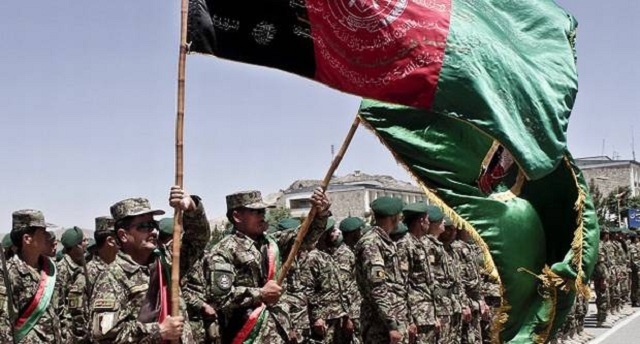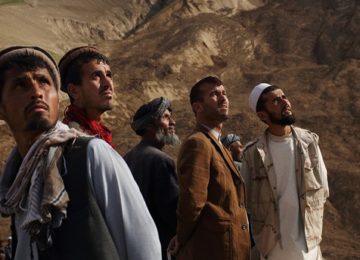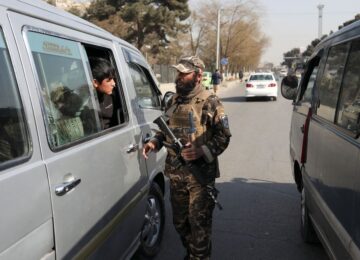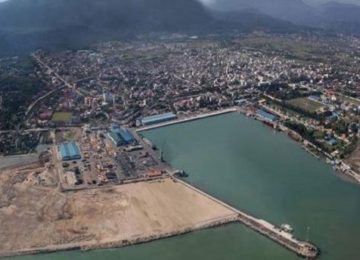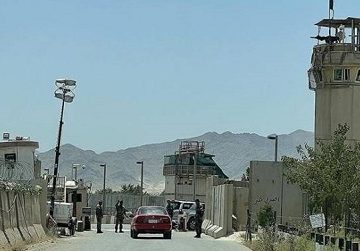Ten years (and a few weeks) ago, in August 2008, a process started that would later become known as enteqal (transition), namely of security responsibility from NATO to the Afghan forces. (*) This process was supposed to be finalised by the end of 2014. Full troop withdrawal was never fully achieved, though. NATO troops’ “watchful eye from the side lines”, as cited in the text, and their quick response in situations of security crises are still indispensable Here is an article (translated from its original German) written for a Berlin-based daily newspaper by AAN co-director Thomas Ruttig less than a year before AAN was formally founded. The article provides a déjà vu– many of the issues described remained unresolved for over a decade now.
From Thursday [28 August 2008] onwards, the Afghan National Army (ANA) will progressively take over responsibility for the security in the Afghan capital Kabul from the NATO-led ISAF mission. The Kabulis will not notice much, though – perhaps only that there will be more ANA patrols in the streets than before. Even the originally planned handover ceremony will not be held. One can also presume that NATO troops will remain present, with a watchful eye from the side lines.
The reason is that security provided by the Afghan security forces has shown a lot of gaps over the past months. They were neither able to prevent the devastating attack at the Indian Embassy in Kabul on 7 July (1) nor an attempt to kill President Hamed Karzai at a military parade on 27 April when the shots fired by a commando of insurgents only just missed him. (2) During the subsequent investigations into the latter incident it turned out that high officers at the Ministry of the Interior had supported the attackers. This cast serious doubts over the ANA and the police’s abilities to assume their newly acquired security responsibilities. “God alone knows what will happen after that,” a Kabuli woman working for an international organisation commented, sceptically.
The transfer of security responsibility was brought up for the first time by President Hamed Karzai at the NATO 2008 spring conference in Bucharest and approved at the Afghanistan conference in Paris in June that year. According to Kabul’s Ministry of Defence, only NATO trainers for the ANA and ANP as well as NATO command centres and logistic bases would remain (…).
Handover to the Afghan forces was supposed to demonstrate abroad that the Karzai government was increasingly able to operate on its own and that the strategy of the US and its western allies to build up effective Afghan forces was working. The fact that the handover will now be implemented without any public event turns the whole affair into a vote of no-confidence on the Afghan forces’ abilities and into an admission that western plans to build them up are way behind schedule. Former Kabul chief of police General Babajan’s recent boasting in Kabul Weekly newspaper, where he claimed the transfer showed that “the Western style of guaranteeing security in Kabul was ineffective” also highlighted that the Afghans dangerously overestimate their own forces’ capabilities.
Starting with the weekend before the now-cancelled handover ceremony, the tone between the Karzai government and the US became sharper. By the end of the previous week, a total of 130 civilians had been killed in two more US airstrikes, one in the western province of Herat and one in eastern Laghman. US representatives vehemently denied that any civilians had been killed in those attacks, but the United Nations confirmed the Afghan government’s reports. (3)
Following these developments, the Afghan cabinet decided to open negotiations with “representatives of the international community” so that, according to Karzai’s spokesman Homayun Hamidzada (contemporary media reports here and here), “air strikes against civilian targets, uncoordinated house searches and illegal arrests of Afghan civilians” by western troops would stop. He said that earlier demands for “moderation” had been “ignored.” Hamidzada further announced that the government wanted to bring all foreign troops “under Afghan law.” Draft legislation would be brought into parliament where emotions about the US attacks have been boiling for several weeks already. One female deputy led a protest of several hundred tribal elders from Logar last week, a province that has also seen a US airstrike. (4)
Hamidzada added that the government was not asking the West to withdraw its troops, though: “This is neither our nor the people’s demand, as we need to strengthen our army before we are able to defend our country [independently].” NATO has responded dryly so far, saying that it has not been notified about any wish for new negotiations.
In contrast to European NATO member states, Washington has so far shown no interest in concluding a status-of-forces agreement with Kabul, which is the international norm and which would define the US troops’ mandate in Afghanistan. In contrast, the deployment of US troops under Operation Enduring Freedom – which does not fall under ISAF’s command – is based on a bilateral “Strategic Partnership Agreement” from May 2005 that largely gives the Americans a free hand to operate at will. Washington also points to the UN Security Council that has mandated the presence of its troops after the terrorist attacks of 9/11. So far, only the Afghan political opposition had demanded to newly regulate the presence of the US troops. Now, it seems, Karzai has joined their bandwagon.
This is mainly related to the presidential elections in 2009. (5) Karzai’s reputation in the country is declining, the insurgent Taleban are portraying him as an “American puppet.” A recent poll by the Kabul office of the German Konrad Adenauer Foundation, asking 1,050 inhabitants in Kabul province, found that only 17 per cent would vote for him again. (6) In the 2005 election, he officially won 54 per cent of the vote countrywide. The security handover of Kabul was meant to be NATO’s campaign support for Karzai. But this has not really worked out well.
The original German article under the title “Unter afghanisches Gesetz” can be found here, at the Berlin daily Tageszeitung’s website (27 August 2008).
Read AAN’s August 2013 dossier, entitled “Looking back at transition“ here.
(*) NATO made “transition” its official strategy for Afghanistanat its Lisbon summit in November 2010 (see here), setting mid-2013 as the time when responsibility for security throughout all of Afghanistan should have been handed over – or “transitioned” – from NATO to the Afghan National Security Forces (ANSF) in a process of five phases (see AAN analysis here). On the Afghan side, transition was handled by Ashraf Ghani, the country’s president since 2014 and then in the role of what had been dubbed the ‘transition czar’ (see media report here).
(1) At that point, this attack was the bloodiest that had ever occurred in Kabul, with 58 people dead, including two Indian diplomats (one the military attaché), and 141 injured, according to UN figures (a media report here).
(2) The attack occurred on 27 April, the mujahedin’s victory day over the regime of Dr Najibullah. Three people – among them one member of parliament, Fazl Rahman Tsamkanai, a Shia community leader and a 10-year old boy – were killed and eleven wounded (media reports here and here).
(3) The airstrike in Herat province was carried out by the US Air Force on 22 August 2008 in the village of Azizabad in Shindand district, in pursuit of a local Taleban commander, according to the US military. It killed an estimated 92 civilians, 62 of them children, according to UN investigations (see report here). After a separate investigation, the US insisted only seven civilians were killed. The airstrike in Garloch village, Laghman, also in August, killed more than a dozen civilians, according to provincial officials, while the US claimed 30 Taleban dead in the strike and “no knowledge of non-combatant deaths” (media reports here and here; exact date and district not reported). According to a later investigation by Anand Gopal, the attack had hit a wedding.
Previous to those attacks, there had been two similar air strikes with 64 civilians killed in total in the provinces of Nuristan and Nangrahar, according to the UN. In both, wedding processions were hit again. In the Nuristan case on 4 July 2008, US troops again claimed they had been fired at and that they had no knowledge of “injured non-combatants.” Provincial governor Tamim Nuristani, however, reported the US attack was in retaliation for insurgent rockets fired at a US base the night before. The Afghan Ministry of Health said that three of its medical personnel and four other government employees were among those killed (media report here). The Nangrahar case happened on 6 July 2008 in Dehbala district (aka Haska Mena) (media report here).
These incidents led to an increase of US-Afghan tensions, as a contemporary BBC report reflected.
(4) In an airstrike on 15 August in Kharwar district, three children were killed (media report here).
(5) This election was held on 20 August 2009, four months after the constitutional deadline. Karzai had stated that he did not want to stay in office “even one day” after his mandate ended in May 2009, but neither the constitution nor the electoral law included any transitional measures for such a case. The oppositional National Front originally demanded that a Loya Jirga be held to solve the problem. But when Karzai adopted this demand, fears arose that he might manipulate the composition and the outcome of the jirga in his favour. The NF then suggested installing an all-party transitional government. None of this came to fruition.
(6) This was a non-representative poll.
By Special Arrangement with AAN. Original link.
Disclaimer: Views expressed on this blog are not necessarily endorsed or supported by the Center for Research and Security Studies, Islamabad.



